Bringing a new puppy into your home is an exciting time, filled with cuddles, playtime, and the joy of a new companion. However, one of the most crucial initial steps for ensuring a harmonious life together is mastering potty training. Done correctly, it lays the foundation for good behavior, establishes a routine, and keeps your living space clean and odor-free. This guide explores the most effective methods for potty training a puppy, helping you to foster a positive relationship and kick off your life together on the right track.
Why Potty Training Is Crucial
Among the many lessons your new puppy needs to learn—from understanding their name to socialization and basic obedience—housetraining should be at the very top of your priority list. It’s more than just preventing messes; it’s about teaching your puppy self-control and setting clear boundaries. Potty training instills discipline, helps your puppy establish a predictable routine, and reinforces that certain areas of your home are off-limits for elimination. A successfully house-trained puppy contributes significantly to a positive and stress-free environment for both you and your pet.
Proven Potty Training Methods
There are several tried-and-true methods for training your puppy, each with its own advantages. According to Mary Burch, Ph.D., director of the AKC’s Canine Good Citizen and S.T.A.R. Puppy programs, while methods may vary, success hinges on following a few basic principles consistently.
Crate Training: A Top Potty Training Tool
Dog crates are invaluable tools that simplify many aspects of puppy ownership, including potty training. Dogs are naturally den animals, seeking out small, secure spaces. This innate instinct makes it relatively easy to train your dog to love their crate. The core principle for housetraining with a crate is a dog’s natural inclination to keep their living space clean. They generally won’t soil their immediate sleeping area.
It is crucial that the crate is the correct size – just large enough for your puppy to comfortably lie down, stand up, and turn around. If a crate is too large, a puppy might feel it’s acceptable to use one corner for elimination and then retreat to another clean corner. Many modern crates come with partitions, allowing you to adjust the internal space as your puppy grows. When your puppy needs to go, they will often signal by whining or scratching, indicating an urgent need to be let out of their den. Ignoring these signals or allowing them to have an accident in the crate can teach them that soiling their living space is acceptable, which can then translate to accidents around your home.
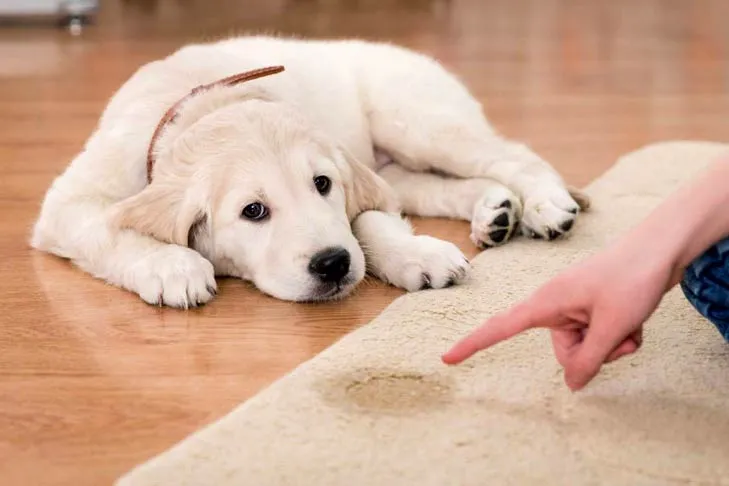 A Golden Retriever puppy looking at a small puddle on a carpet, indicating a potty training accident.
A Golden Retriever puppy looking at a small puddle on a carpet, indicating a potty training accident.
Understanding Puppy Pads and Paper Training
The use of puppy pads or paper training can be a nuanced approach, notes Dr. Burch, as it can inadvertently reinforce two different options for your puppy. Ideally, puppies learn to hold their bladder indoors and eliminate only in designated outdoor spots. However, in specific circumstances, such as for owners with demanding work schedules that prevent frequent outdoor trips, or for tiny dogs living in areas with harsh winters, puppy pads can offer a practical solution.
Puppy pads provide a sanctioned indoor spot for your dog to relieve themselves. There are also indoor dog potties available that even cater to male dogs. The strategy here is to initially teach your puppy to use these indoor spots, and as they mature, transition them to doing their business exclusively outdoors. This method requires careful management to ensure the puppy understands the eventual goal of outdoor elimination.
Creating an Effective Housetraining Schedule
Consistency is the bedrock of successful housetraining. Puppies have small bladders and immature digestive systems, meaning they need frequent opportunities to relieve themselves. You must provide ample chances for your puppy to do the right thing in the right place.
A general guideline suggests that puppies can control their bladder for a number of hours equivalent to their age in months, up to about 9 months to a year. So, a 6-month-old puppy might hold it for around 6 hours. However, remember that individual puppies vary, and 10-12 hours is a long time for any dog to hold it. When developing a schedule, closely monitor your puppy’s daily habits. Very young puppies will need to go out frequently, often:
- First thing in the morning and last thing at night.
- After playing indoors.
- After waking up from a nap or spending time in their crate.
- After eating, drinking, or chewing a toy or bone.
Following this regimen could mean taking your puppy outside a dozen or more times within a 24-hour period. If you work outside the home, consider making arrangements for a dog walker or a trusted friend or neighbor to help maintain this critical schedule. The faster your puppy learns that there are approved potty spots and off-limit areas, the sooner you can move past the messy phase of puppyhood.
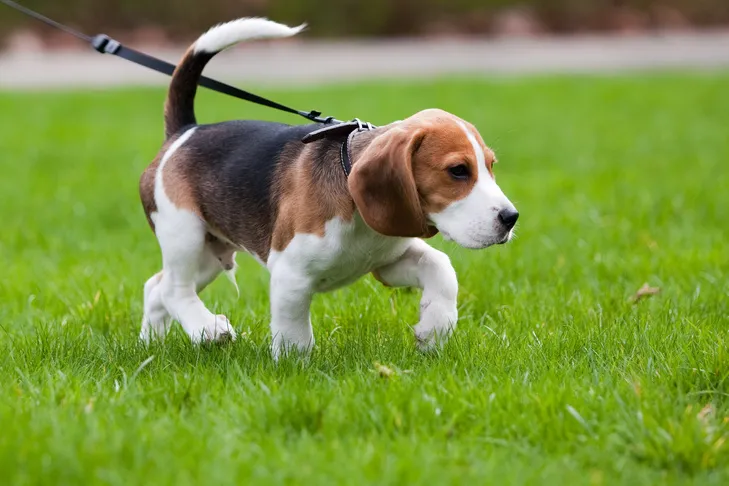 A Beagle puppy happily walking on a leash through green grass, getting fresh air and exercise.
A Beagle puppy happily walking on a leash through green grass, getting fresh air and exercise.
Observing Your Puppy’s Potty Habits
Successful potty training demands keen observation. Each puppy is an individual with unique signals and rhythms. Some might be able to hold it longer than others, while some will need to go out almost every time they play or get excited. You might even encounter puppies who pause mid-play, relieve themselves, and then continue playing as if nothing happened. Just like human babies, canine potty habits are highly idiosyncratic. Paying close attention to your puppy’s cues—sniffing, circling, squatting, or showing restlessness—can give you a head start in preventing accidents. Learning their personal schedule and subtle signs will significantly improve your response time and training success.
Managing Your Puppy’s Diet for Better Potty Training
A puppy’s immature digestive system means they cannot handle large quantities of food. It is generally recommended to divide your puppy’s daily food intake into three small meals. Equally important is the quality of the food itself; always opt for the highest quality puppy food that agrees with your specific dog. Any changes in diet should be introduced gradually to avoid digestive upset.
Monitoring your dog’s stool is an excellent way to gauge their digestive health and determine if a diet change is needed. If your puppy consistently produces bulky, loose, or unusually stinky stools, it’s advisable to consult your veterinarian. They might suggest switching to a new dog food formula. Overfeeding can also lead to diarrhea, which will make the already challenging task of housetraining even more difficult. A consistent, high-quality diet supports stable digestion, making potty training more predictable and successful.
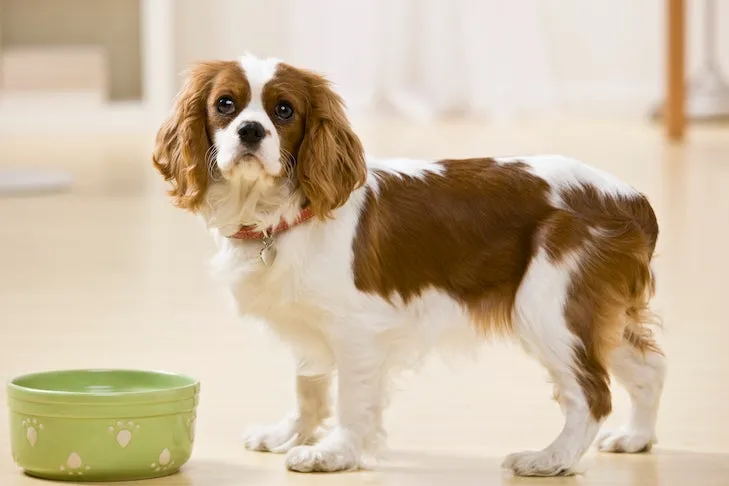 A Cavalier King Charles Spaniel standing calmly next to its food bowl inside a home, showing a well-established routine.
A Cavalier King Charles Spaniel standing calmly next to its food bowl inside a home, showing a well-established routine.
Positive Reinforcement for Outdoor Success
When it comes to potty training, positive reinforcement is vastly more effective than punishment. Scolding a puppy for an accident, especially after the fact, serves little purpose as they won’t associate the scolding with the act. Instead, lavish praise and rewards when your puppy successfully eliminates outside. Make them feel like a genius every time they perform this natural act in the correct spot.
Be enthusiastic with your praise—cheer, clap, offer small, easily digestible treats. Your goal is to make them understand that this accomplishment is incredibly important. If an accident does occur indoors, avoid making a fuss. Simply clean up the mess thoroughly, as advised by Dr. Burch. Use a high-quality enzymatic cleaner to eliminate all odors, preventing your dog from being attracted to the same spot in the future. Blot up any liquid on carpets before applying the cleaner. If you catch your puppy in the act of squatting indoors, immediately pick them up and rush them outside. If they then finish their business outdoors, reward them generously. Prevention and positive reinforcement are the cornerstones of effective potty training.
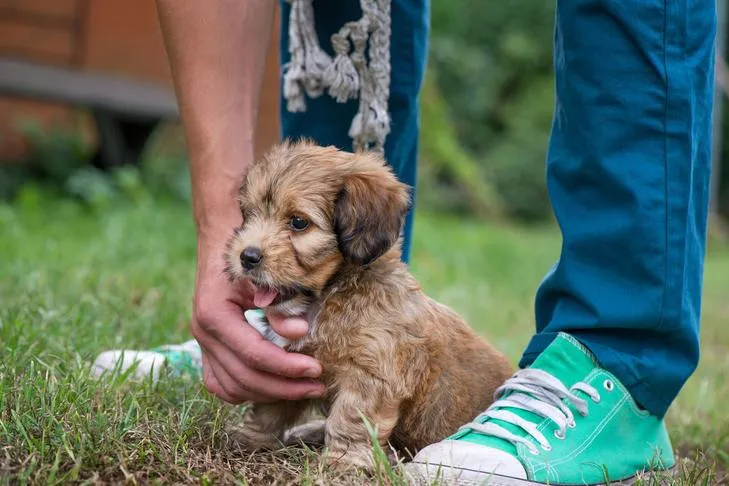 A puppy being guided by its owner on a leash in a grassy outdoor area, demonstrating positive reinforcement during training.
A puppy being guided by its owner on a leash in a grassy outdoor area, demonstrating positive reinforcement during training.
Troubleshooting Common Potty Training Problems
Even with the best efforts, potty training doesn’t always go smoothly. When problems arise, it’s essential to identify the root cause. Dr. Burch emphasizes that persistent house soiling could indicate an underlying physical issue. If a puppy seems impossible to housetrain, especially before several months of age, a thorough veterinary check-up is recommended. If your vet confirms your dog is healthy, the next step might be to consult a professional trainer or animal behaviorist experienced in these challenges.
Here are some frequent issues and their solutions:
Frequent Indoor Accidents
This issue is common among owners of Toy breeds, who might find it challenging to get their small dogs to go outside frequently enough. For these breeds, teaching them to use indoor potty spots, much like a cat uses a litter box, can be effective. This can involve dedicated indoor dog potty boxes in addition to piddle pads. Trainers assert that with consistent effort, even small dogs can be successfully house-trained, though it may require a bit more time, attention, and dedication.
Repeated Accidents in the Same Spot
If your puppy repeatedly soils the same indoor spot, it’s likely due to inadequate cleaning after previous accidents. Even if a spot appears clean to you, residual odors can signal to your dog that it’s still an acceptable place to eliminate. Your new puppy supply kit should include plenty of pet stain enzymatic cleaners. These cleaners are specifically designed to break down and eliminate odor-causing molecules. Always follow the product instructions carefully to ensure the scent is completely removed.
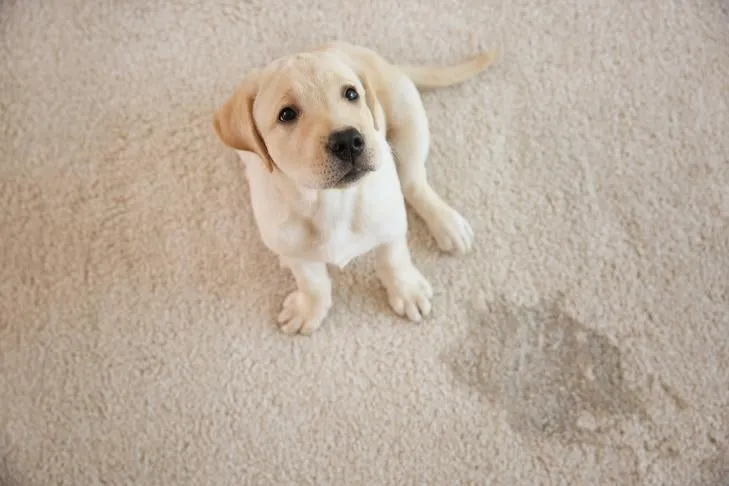 A Yellow Labrador Retriever puppy sitting on a carpet next to a fresh pee accident, highlighting the need for thorough cleaning.
A Yellow Labrador Retriever puppy sitting on a carpet next to a fresh pee accident, highlighting the need for thorough cleaning.
Granting Too Much Freedom Too Soon
A common mistake among new dog owners is declaring victory too early. After seeing a few days or weeks of success, owners might grant their puppy full run of the house, only to return home to a mess. Even when your puppy seems to be grasping the concept, it’s vital to stick to the established schedule and maintain supervision to ensure good habits are fully ingrained. Gradually increase freedom only after sustained, consistent success.
Soiling the Crate
Crate soiling can be particularly disheartening. Dr. Burch notes that rescued dogs who have endured long confinement and had no choice but to eliminate in their kennels might continue this behavior. For such cases, or for any puppy soiling its crate, it’s best to restart crate and house training from square one. This involves:
- Assessing your dog’s bladder and bowel control outside the crate.
- Strictly controlling their diet and potty schedule.
- Providing frequent outdoor trips, particularly after every meal, first thing in the morning, and last thing at night.
- If you are away for extended periods, arrange for a dog walker or a trusted individual to let your dog out.
- Always thoroughly clean any accidents in the crate to eliminate all odors.
How Long Does Puppy Potty Training Take?
The duration of puppy potty training can vary significantly, as highlighted by Dr. Burch. Factors such as the puppy’s age, their previous learning experiences, and your consistency and chosen methods all play a role. An 8-week-old puppy will have vastly different developmental capabilities compared to a 5-month-old puppy. Some puppies may achieve perfect manners in just a few days, while others might take several months, especially if they came from less-than-ideal circumstances. Regardless of the timeline, patience and persistence are your most valuable tools. Most dogs, with dedicated effort, can learn to be reliably house-trained.
By understanding your puppy’s needs, implementing a consistent routine, utilizing positive reinforcement, and addressing challenges proactively, you’re well on your way to discovering The Best Way To Potty Train A Puppy and enjoying a clean, happy home with your beloved canine companion.
